What is a Teleological Object?
How to Constellate: 1
Envision if you can, a spaceless, timeless ganglion hovering just beyond the reach of thought and sensation.
It has no shape, no volume, no mass and no substance. It does not look like anything, but things can occasionally look “like” it. It is incomprehensibly intelligent, but having no physical needs, is utterly, exotically dispassionate.
To ask what it is is the wrong question, because it has no ‘what,’ and yet it is.

I am describing to you what I call a “teleological object” or TO for short. Here, I use the term “object” in the most loose and abstract sense, akin to its use in mathematics.
It’s a kind of cosmic gene that governs the manner in which reality is allowed to unfold across time. It might be an aspect of consciousness which imposes a dimension of coherence and intelligibility upon potentiality.
A flipped coin can land on heads or tails. It cannot land on heads and tails. This is an apparently trivial fact, but it is really a rudimentary illustration of a cosmic principle with far-reaching connotations.


The binary potential of the coin imposes a hard and natural limit upon the set of possible futures. But there are some such hard limits which may not be so obvious.
It is impossible for me to be in Paris in an hour. Even though the explicit laws of physics technically allow this, the current pieces in play are moving along trajectories, which conspire together as a diffuse, invisible wall forbidding that outcome.
The collapse of the wave function is mediated by the laws of logic which are imposed by observation upon reality. From these laws of logic proceed those of mathematics. From these, those of physics. But whence do those laws of logic proceed?
Position is negation. If heads is up, tails must be down. This is the point: there is an intelligibility to the manner in which “this” is posited and “that” is negated. That intelligibility is described by the structure of the teleological object, the underlying or overarching principle which unites all possible states and excludes all impossible states of a given set. It is not a logical principle, but a principle transcending logic, anterior to logic, which gives logic its being. Something further upstream which makes logic logical, and which logic inevitably serves and recapitulates.
The only term our culture has ever formulated for this metalogical thing is “the logos.” A teleological object is an aspect thereof — a refracted hue of that white light.
The larger point is that that which is physically possible is only thus insofar as it is logically possible. Logic in like manner conforms to archetypal intelligibility; the logos.
This is why systems of representation that are incompatible at the logical level can be reconciled analogically (e.g. Christianity and Gnosticism in the cosmogram).
By extension, this would imply that the physical is subordinate to the archetypal. An event must be symbolically coherent “before” it can be physically possible, because the wave functions which we observers collapse into realized logic (e.g. “if x, then not y”), get their probabilistic structure from archetypal schemas which describe the set of all possible measurements. In other words: the laws of physics do not describe any symbolically incoherent timelines except hypothetically.
Sounds like a word game. Relativity also looks banal until you start splitting atoms.
I struggled to find a good thinking tool with which to analogize the concept of the TO until I started fidgeting with a Rubik’s cube. Ernő Rubik, the inventor of the cube was a Hungarian professor of architecture, and he must have also been divinely inspired.
I don’t care what anybody says, these things are not from here:
The Rubik’s Cube has 43 252 003 274 489 856 000 possible configurations, most of which have never been physically made by humans — but there is a kind of syntactical metastructure that binds them all together. For example, the relative positions of the centers are conserved in all arrangements. Likewise, twisting a single corner piece will create a state outside of the original ~43 quintillion from which there is no path to the solution.
There are likewise rules about how you can and can’t move from one configuration to another. It was proven by a team of researchers using a supercomputer that every possible configuration can be solved in 26 moves or less (if a 90° turn = 1 move).
Thus 26 was (correctly) declared “God’s number” in the quarter-turn metric.

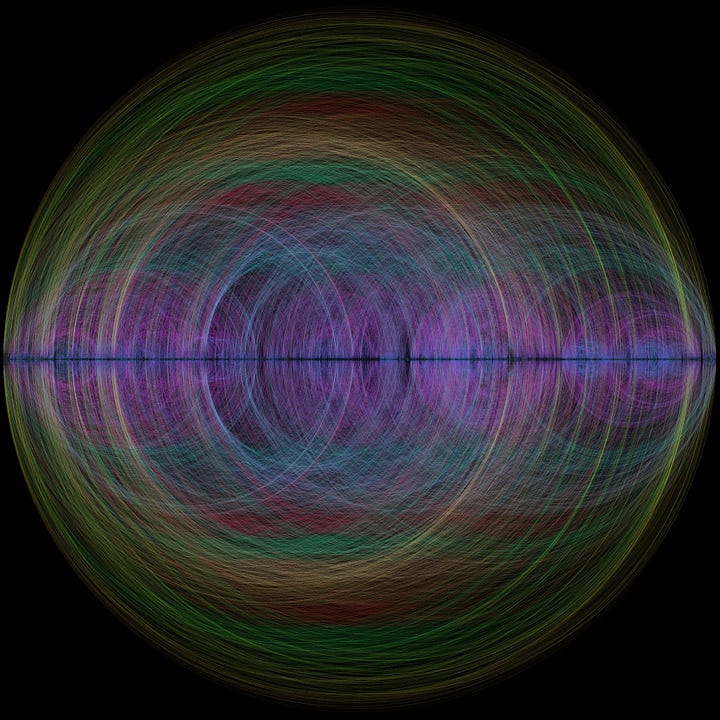
Imagine a vast graph with ~43 quintillion nodes, each corresponding to one unique configuration. Imagine each node connects to 12 others (all the adjacent permutations). It would look a bit like a network of neurons but one in which all possible connections are realized.
This would represent the “maze” of the Rubik’s Cube which you are navigating while solving, traversing from node to node with each move.
Hopefully my esoteric ‘word salad’ is now beginning to touch ground.
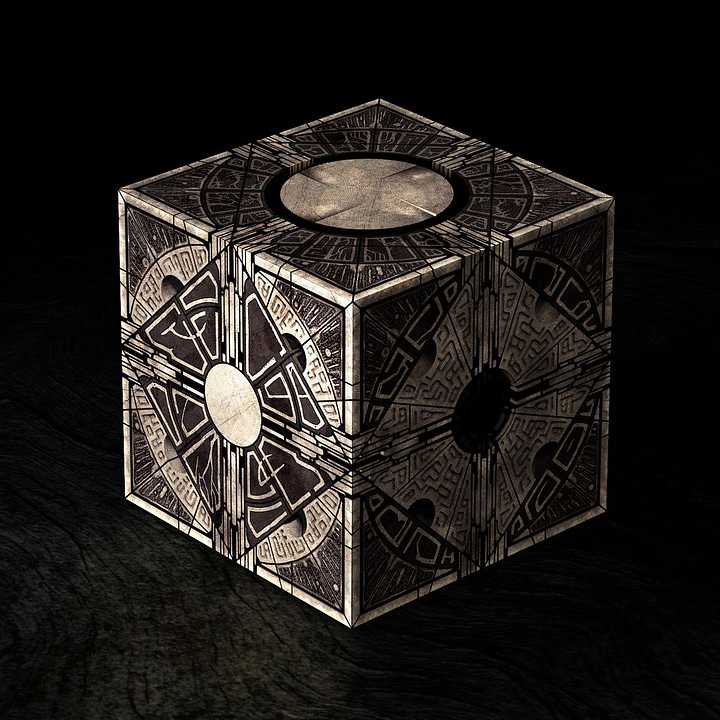
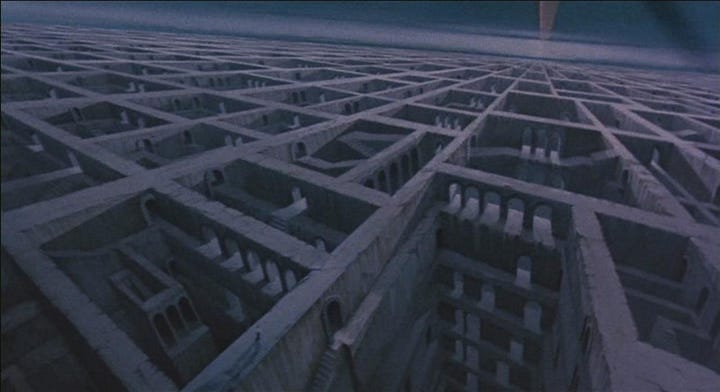
That graph or labyrinth would have no objective center, as every node would have exactly 12 neighbours. However, the “solved” configuration is the most archetypal. It is in some way “right,” inherently desirable and magnetic to consciousness like an attractive face, and so it constitutes a spiritual center of this maze.
Even though any configuration could represent “the cube outside of time,” the solution is uniquely set apart and teleological and so we can use it as a visual representative of the cube’s teleological object.
Thus, we could flatten this enormous graph and depict its syntactical structure supervening upon the set of all possible cube states like so:
The idea we are depicting here is that the “teleological object” (represented here by the solution) by virtue of its inherent structure contains and implies all possible states (and all possible continuous sequences thereof). Likewise, every state is imprinted with an “image” of the TO; an implicit genetic code consisting of encrypted information about the maze and that state’s relative position therein.
If you know how to solve the cube (or literally: how to constellate) not only will manifestations of these images render more intelligible information to you, but they will also appear to you more often.
This is not simply a subjective effect, the world around the constellating mind will actually become more coherent the same way the Rubik’s Cube does as you approach the solution. We are no longer simply toying with reality, making guesses and hoping for the best, but actually bringing “the best” into being through meticulous and sober dialogue with the underlying substrate of reality.
One of the first analogies I ever imagined for the TO came to me as I watched an ant walking along a table on my back deck. The ant, I realized, was not equipped to perceive a table as a table. He perceived it as terrain, not as a coherent object. But if we were to feed all of his sense data into a supercomputer as he walked along its entire surface and then correlated all of that data, we could “fold up” what he experienced and excavate the table from the correlations.
If analogous supercoherent systems at the human level were naturally occurring, our nervous systems would evolve to navigate them the same way that birds adapted to magnetic fields and bees to electrical fields. We would not need to be conscious of this and we probably wouldn’t be. The landscape would simply implant suggestions into our unconscious processes.
David Bohm, a theoretical physicist, and colleague to both Albert Einstein and J.R. Oppenheimer challenged quantum orthodoxy by introducing the idea of the implicate (or “enfolded”) order to explain quantum behaviour.
He posited that the universe is much more interconnected than it is observed to be by humans. That our phenomenological world of discrete things (the explicate order) is simply an expression of a much more unitary and coherent process than the multiplicity of processes perceptible to the senses.
He suggested that the implicate order was “reality” while the explicate order was like a sequence of evolving holographic projections of that reality — something I have also proposed.
The implicate order is like the inner workings of a computer, while the explicate order is what appears on the monitor.


Bohm was a determinist dissatisfied with the probabilistic indeterminacy and observer-dependency posited by the Copenhagen interpretation of quantum mechanics and was formulating a model (Bohmian mechanics) that could save Newtonian determinacy from the strangeness of the quantum world.
His view stands in stark opposition to the observer-participant universe and participatory anthropic principle of John Wheeler, who embraced and elevated the quantum indeterminacy and the role of observation to positions of cosmic significance. Wheeler posited that cognition actually closes the circuit that realizes potentiality. This is the view usually favoured by the chaos magicians.



Many new agers believe that consciousness collapses the quantum wave function, but Wheeler was a disciplined empiricist. He was most interested in the information theoretic dimension of state reduction. For him, transmitters (past) and receivers (future) co-create messages, and these information-theoretic messages constitute reality. The idea is encapsulated best by his famous summary “it from bit.”
My stance, as per usual, is not quite on either side. I think Wheeler was right about the role of measurement in the collapse of an indeterminate wave function, however, I think there is a loose determinism that governs this generative participation, and that it rhymes with Bohm’s implicate order in important ways.
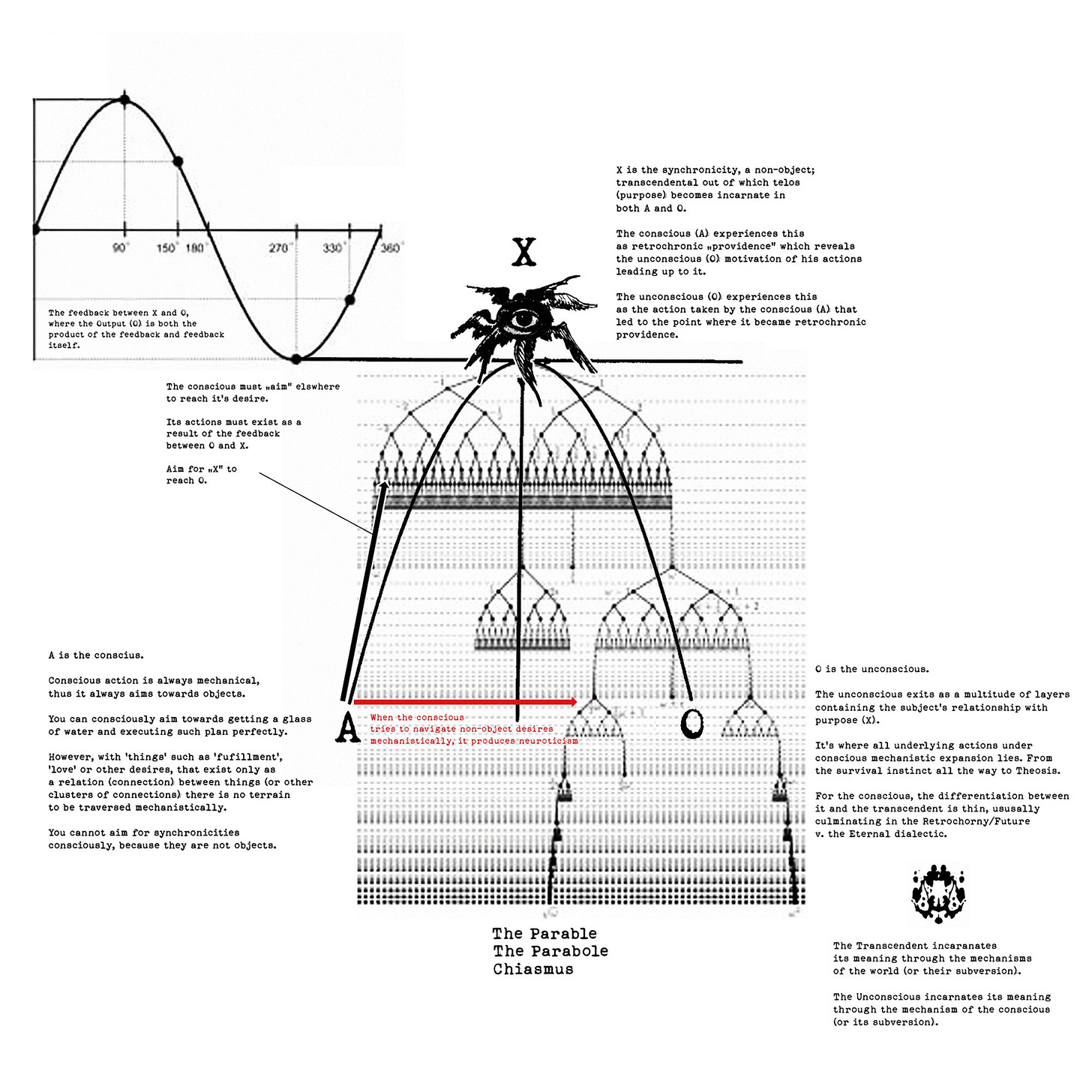
Namely, in the same manner that “if heads is up, tails must be down,” I suspect that when quantum states reduce at a given place and time, this necessitates an “equal and opposite” or compensatory result elsewhere and/or elsewhen. In other words, if an artificial “peak” (heads) is made in one place, a corresponding “trough” (tails) must appear elsewhere. Moreover their sum will be zero, ensuring that these transient effects do not alter the transcendental identities of anything.
This heads-tails parity is a consequence not of any physical law, but of a psychological law, for the same parity exists in the psyche where ego and unconscious are always equilibrated by a fulcrum: the Self.
If information processing realizes potentiality, then psychic states must condition physical states. If that is true, then enantiodromia and other archetypal dynamics will have a definite effect upon physics at the macroscopic scale.
It isn’t even necessary to argue that mental states affect how quantum superpositions collapse (although this remains a possibility). Even if we suppose that states of consciousness have no causative effect upon the collapse of superpositions at all, it is sufficient that they impel the actions of the observer who determines where, when and which observations are made and not made.
None of this hangs upon consciousness being magic (even though it is).

These simple facts result in an emergent principle which I call the “conservation of identity.” This law, I propose, is what causes symbolism (and intelligibility more broadly) to manifest in physical space and time.
My thesis is that logic, mathematics and the sciences faithfully describe the explicate order. However, the same archetypality which governs the unconscious governs the implicate order beyond logically intelligible reality, and indeed that in practice, the collective unconscious and implicate order are two names for one thing.
I have been very consistent in depicting TOs as octahedra and even I never really understood why I started doing this.
The shape I saw above the maze on December 21st, 2022 was actually an icosahedron. I changed it to an octahedron in the diagram above mostly because it was easier, but also as an homage to the strange star gate diamonds in 2001: A Space Odyssey which captured my imagination when I first saw them.
Nevertheless, when the octahedron was chosen, it snapped into place and stuck. I agonized over the meaning of this for months, dissatisfied with simplistic and rigid correspondences between the Platonic solids and the elements.
Then I discovered that the reason we call an octahedron a “diamond” is because the gemstones with the same name crystallize into the same shape.


the diamond is made of a cubic lattice of carbon atoms (element 6). Being the hardest mineral, the diamond gets its name from the Latin “adamas” meaning inflexible or lasting. It can also mean invincible, unyielding or even inexorable.
From adamas comes the English word: adamant.
Let’s return briefly to our Rubik’s Cube. Recall that the center blocks have fixed positions. Together, these six pieces form an octahedron contained in a cubic lattice. The cube is variable, but this inner diamond abides unchanged through all transformations. You can reorient it, but you can’t alter it. Diamonds really are forever.

We may say therefore that in this context, the outer cube (a) symbolizes the world, Adam and time, but the inner octahedron (b) symbolizes the Kingdom, Christ and eternity, and that the kingdom of God is within you (c).
I noted once before that the unicursal hexagram is a projection of an octahedron and that the hexagram has similar characteristics.
I take the symbolic association with the diamond to partially illustrate the “multifaceted” and refractive nature of TOs — the way that the shadows these objects cast upon time and space truly “mean themselves” and are not reducible to any semiotic explanation or equivalence à la “the blind men and the elephant.”
the octahedron’s association with 8 in a Christian context links it to the eighth day of creation; Christ, the logos and the resurrection. The octahedron survives the death of the cube and then resurrects it. This is the philosopher’s stone which transmutes the black cube into the New Jerusalem, lead into gold, death into glory.
From a Jungian angle, the cube may be seen as a symbol of the ego and the octahedron as the quaternitarian symbol of the Self — that which survives all psychic transformations. Solving the Rubik’s cube thus represents both individuation and the alchemical purification of base matter.
Fixed and transcendent identities like the ever-aligned intersections of Pascal’s hexagram and the immovable centers of a rubik’s cube offer what I think is the most sensible account of synchronicity. It is, in effect, a mathematically necessary expression of an underlying unity. So elegant is this divine music, that it plays even through the semiotic ephemera of a chaotic human life, like a child’s toy made with no higher meaning in mind.
I do not mean to suggest here that synchronicities arise out of the mechanism of mathematics. On the contrary, I’ve every reason to believe it’s the other way around.







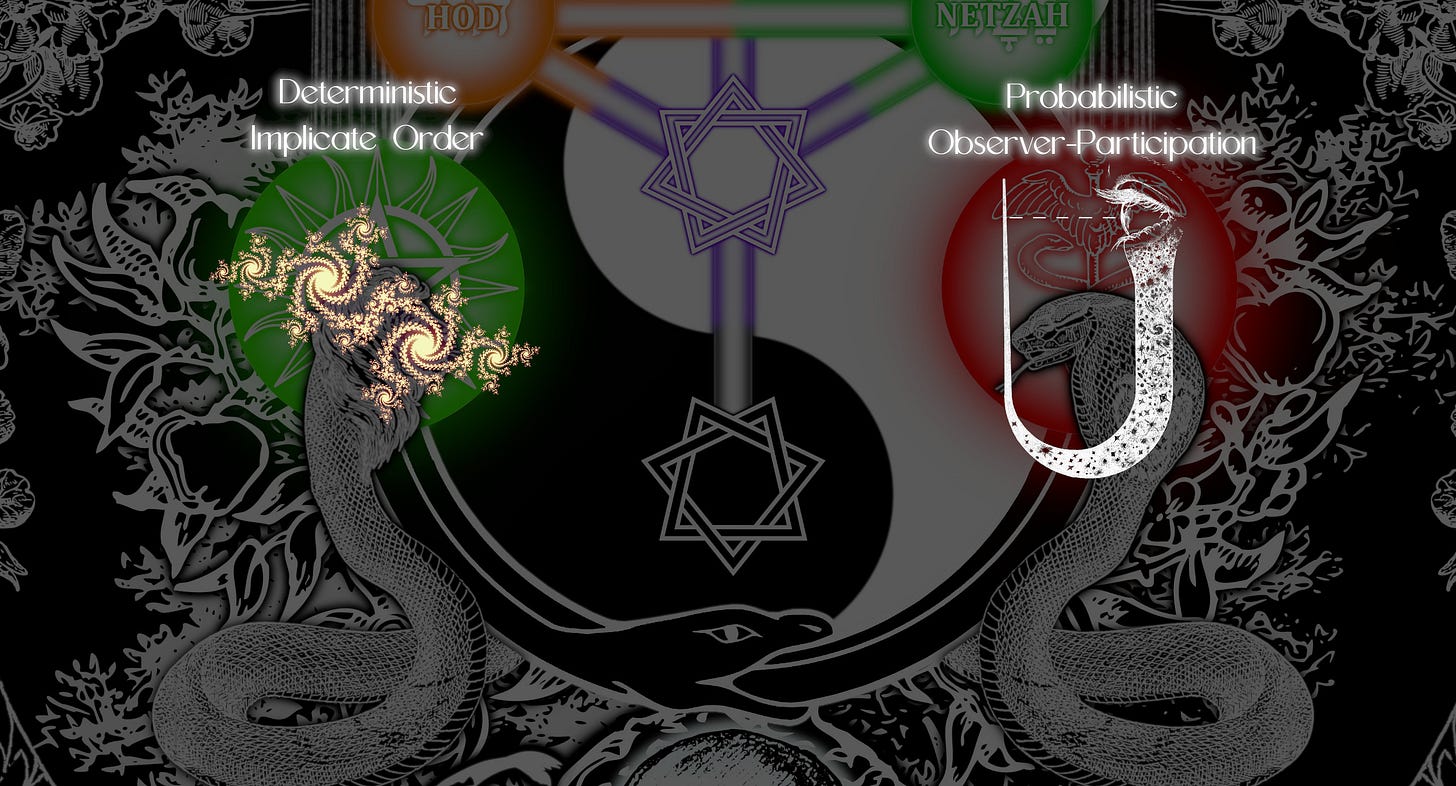

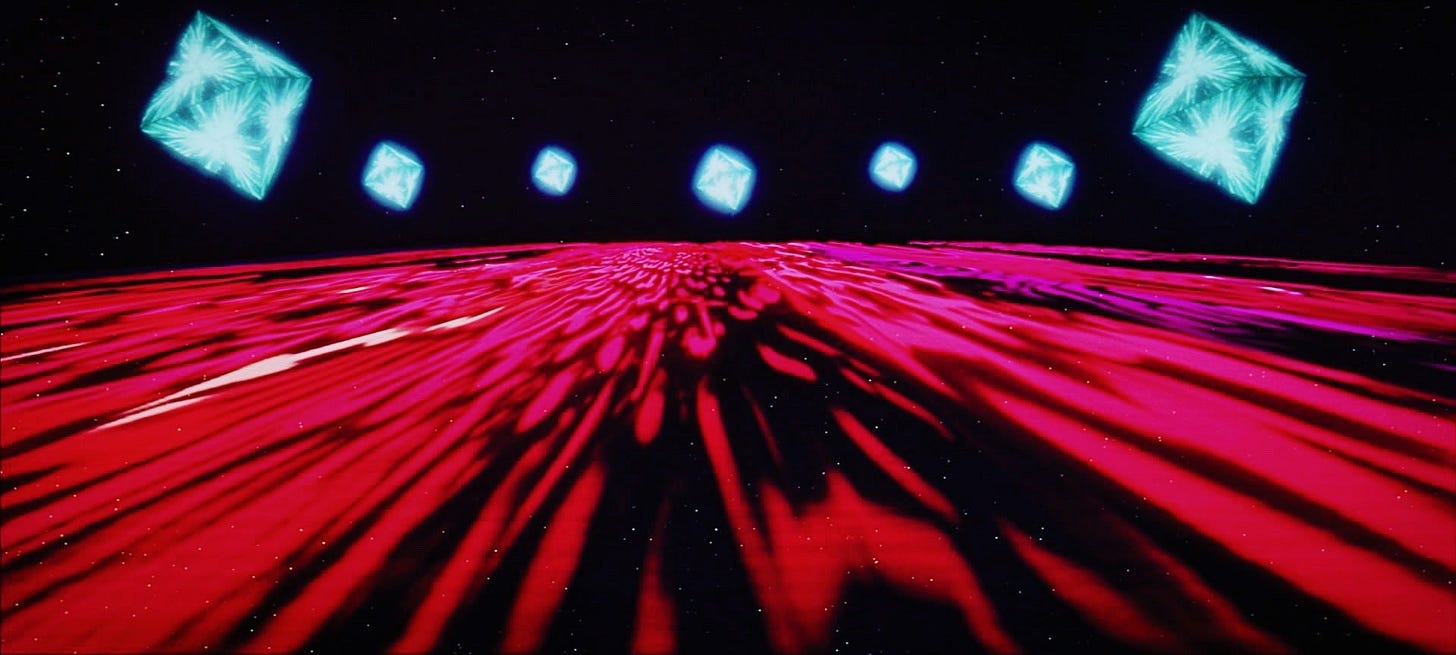
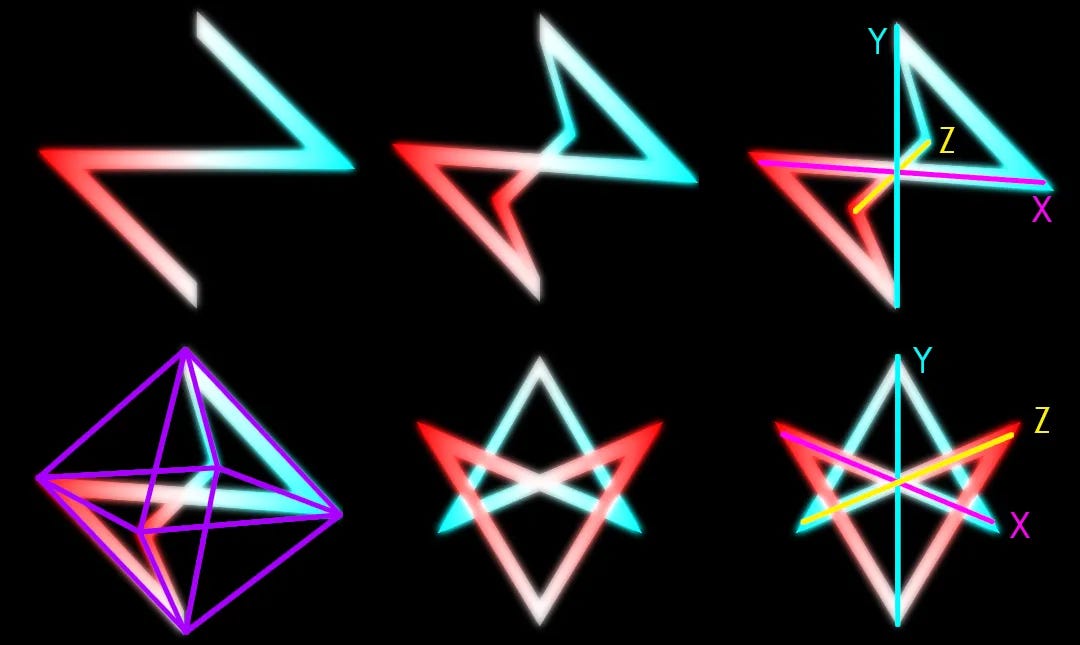
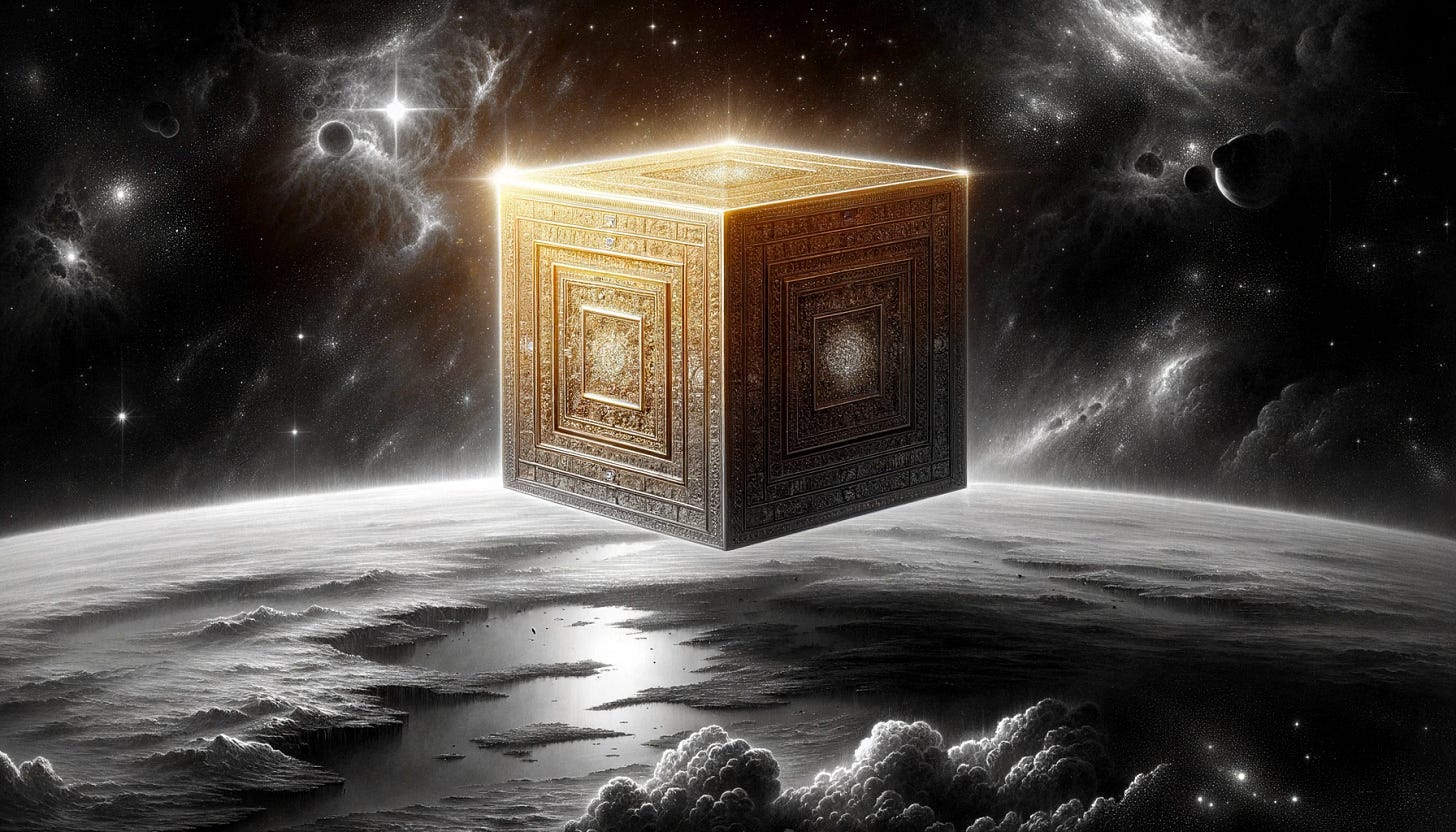
I like how you have incorporated scientific language to explain supermundane concepts. Describing the TO as the “genes” of the universe rather than referring to it as the “spirit” as earlier metaphysical investigators would have is quite clever. Although maybe the analogy isn’t as close, the idea conveyed is clearer when referred to this way.
Feels like you've just discovered the Flux capacitor.
Once this baby hits 88mph, you're going to see some serious shit!
Have you seen the Back to the future series? I'd be interested in your take on it. It might be worth a rewatch.
https://youtu.be/LjriZhDoyNQ?si=deWE687tsVANvyLW